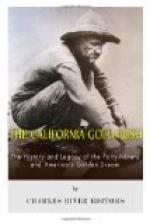Of public improvements there were almost none. The few that were undertaken sprang from absolute necessity. The town got through the summer season fairly well, but, as the winter that year proved to be an unusually rainy time, it soon became evident that something must be done. The streets became bottomless pits of mud. It is stated, as plain and sober fact, that in some of the main thoroughfares teams of mules and horses sank actually out of sight and were suffocated. Foot travel was almost impossible unless across some sort of causeway. Lumber was so expensive that it was impossible to use it for the purpose. Fabulous quantities of goods sent in by speculators loaded the market and would sell so low that it was actually cheaper to use bales of them than to use planks. Thus one muddy stretch was paved with bags of Chilean flour, another with tierces of tobacco, while over still another the wayfarers proceeded on the tops of cook stoves. These sank gradually in the soft soil until the tops were almost level with the mud. Of course one of the first acts of the merry jester was to shy the stove lids off into space. The footing especially after dark can be imagined. Crossing a street on these things was a perilous traverse watched with great interest by spectators on either side. Often the hardy adventurer, after teetering for some time, would with a descriptive oath sink to his waist in the slimy mud. If the wayfarer was drunk enough, he then proceeded to pelt his tormentors with missiles of the sticky slime. The good humor of the community saved it from absolute despair. Looked at with cold appraising eye, the conditions were decidedly uncomfortable. In addition there was a grimmer side to the picture. Cholera and intermittent fever came, brought in by ships as well as by overland immigrants, and the death-rate rose by leaps and bounds.
The greater the hardships and obstacles, the higher the spirit of the community rose to meet them. In that winter was born the spirit that has animated San Francisco ever since, and that so nobly and cheerfully met the final great trial of the earthquake and fire of 1906.
About this time an undesirable lot of immigrants began to arrive, especially from the penal colonies of New South Wales. The criminals of the latter class soon became known to the populace as “Sydney Ducks.” They formed a nucleus for an adventurous, idle, pleasure-loving, dissipated set of young sports, who organized themselves into a loose band very much on the order of the East Side gangs in New York or the “hoodlums” in later San Francisco, with the exception, however, that these young men affected the most meticulous nicety in dress. They perfected in the spring of 1849 an organization called the Regulators, announcing that, as there was no regular police force, they would take it upon themselves to protect the weak against the strong and the newcomer against the bunco man. Every Sunday they paraded




